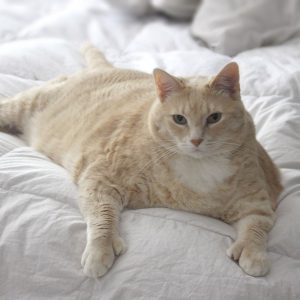Causes of Feline Obesity
Gross obesity in cats can be caused by anyone, or more often, a combination of the following: The single worst food for cats is a high-carbohydrate, corn-laden dry food, rich in calories, but short on a named meat protein. Obligate carnivores must have muscle meat protein to live, such as chicken, turkey, fish, rabbit – the sorts of food cats eat in the wild.
Free-Feeding Dry Food
- Ideally, a cat should be fed three to four small meals a day, preferably raw or freeze-dried food or a good quality canned. However, many cat owners are dual income, and there is no one home during the day to feed the cats. Hence, they often resort to using “free-fall” dry food feeders, which allow new food to flow into the bowl as cats eat.
Fortunately, the pet industry has recognized this problem, and now there are portion-controlled feeders, even timed ones. One good option is the Smartcat Tiger Diner Food Dish. Some models include a one-cup container, which can sit upright on top of the dome: alternatively, food can be poured through a hole in the dome. Below is the wide portion of the food dish, which has holes around the side, through which the cat can stick his paw to draw out bits of kibble to eat. This “controlled grazing” is completely ineffective with a high carbohydrate, high fiber diet. Try to feed your cats healthier foods, such as Royal Canin or Hills Prescription Diet, which can be found here at Parkgate Animal Hospital.
- Insufficient Exercise
You will find very few obese cats among those who are allowed free access to the outdoors. They get plenty of exercise climbing trees, jumping over fences, and running from dogs. It isn’t a good idea to allow cats to run freely outdoors as a solution to weight problems.

With climbing towers, scratching posts, and interactive toys, cats can be happily active inside, to help keep their weight in check and to develop and maintain sound, healthy bodies. Also, there are safe outdoor alternatives, such as walking your cat on a leash, or building an outdoor cat enclosure. Most cats can be trained to a harness and leash quite easily. - Hypothyroidism
Although it is rare, hypothyroid disease can cause cats to become overweight. Fortunately, daily supplements of thyroxine can cause a quick turnaround.
Common Diseases in Obese Cats
Although these serious diseases are not exclusive to overly-fat cats, feline tubbies are more predisposed to develop them.
- Arthritis
Obesity and arthritis in cats become a double-edged sword. The extra weight on load-bearing joints becomes painful arthritis; because of the pain when walking or jumping, the cat becomes more sedentary, burns fewer calories, and gains more weight unless his eating pattern changes. Arthritis in cats can become a crippling disease, one which our cats simply don’t deserve.
- Diabetes
Feline Diabetes Mellitis is the single most common disease that targets overweight cats and is almost always directly related to diet. Lisa A. Pierson, DVM, of CatInfo.org, wrote about Feline Diabetes:”Feeding a diabetic cat a high carbohydrate diet is analogous to pouring gasoline on a fire and wondering why you can’t put the fire out.”
- This rationale also applies to any of the prescription dry diabetes diets such as Purina DM, Hill’s Prescription w/d and m/d, and Royal Canin DS. These diets are not only poor quality diets, they are still too high in carbohydrates and contain several species-inappropriate, hypoallergenic ingredients such as corn, wheat, and soy.
- Hepatic Lipidosis (Fatty Liver Disease)
Fatty liver disease develops when a previously overweight cat loses weight quickly, sometimes the result of untreated feline diabetes, hyperthyroidism, or simply because the cat feels unwell. Although it is potentially fatal, fatty liver disease can be turned around quickly by prompt diagnosis and treatment.
Check out this article if you wish to know about obesity in dogs.

